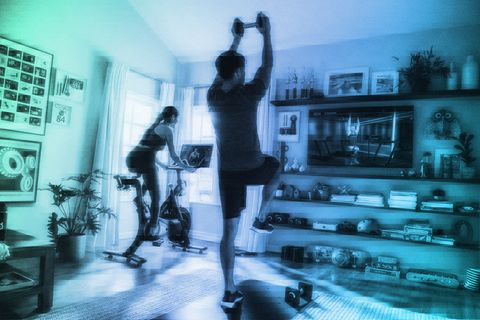6 Ways COVID-19 Changed the Gear World for Good
One year ago, we found ourselves swirling in a strange new reality defined by an invisible virus and a global pandemic. To stabilize the situation, we grasped at things: we stocked up on TP, hand sanitizer and booze. When it set in that things would be this way not for weeks, but months, we doubled down, swapped public transit for bikes, bought enough kettlebells to cause a shortage and downloaded Zoom on every screen. Daily life changed, and so did the things we filled it with.
Now, thanks to the tireless efforts of essential workers and the fastest vaccine development program in history, we’re edging close enough to that so-called light at the end of this dark tunnel that we can catch a glimpse of what’s on the other side.
But heads up: It isn’t the same world we left behind.
Products provide the proof. Some pandemic product trends, like brass button pushers and, yes, bidets (at least in the US), will fade away as fads. Others won’t. The residue of COVID-19 is evident on everything from how we buy watches to how we work out, and it will be for years to come. But don’t worry — it’s all good.
Car Camping Is Here to Stay
RV and travel trailer sales surged in 2020 as camping and road-tripping became one of the only ways people could vacation, and they’re holding firm this year going into the summer, as well. But while recreational vehicles are novel and fun at first, they can be an expensive pain to hang onto as time goes on. In effect, an RV requires the maintenance of both a motor vehicle (oil changes, powertrain wear and tear, suspension issues) and a house (plumbing problems, leaking roofs, etc.). A travel trailer like an Airstream isn’t significantly better: while it may not have a powertrain, it still has ample moving parts that require upkeep and maintenance, and it forces owners to be comfortable towing a long, awkward contraption behind them wherever they go. Not to mention all the driveway space they require when you’re not vacationing.
Car camping, however, is a more approachable hobby, and as such, much more likely to remain popular after COVID-19 is in the rearview. It requires far less gear and far less expense than more elaborate forms of temporary mobile living: Assuming you have a car already, as most Americans do, all you need are a good tent (ideally one that lives on your roof), a camp stove and a solid cooler to open up new worlds of exploration and travel. When car camping, you can take day hikes in several states over a week, see new vistas every day and bed down in new places every night — and with the nearby reassurance of a sturdy emergency shelter, power supply and escape pod.
If you have an off-road-ready truck or SUV, car camping quickly translates to overlanding. The world of overlanding was already rising in the zeitgeist before coronavirus struck, but as with RVs, the appeal of getting far away from people via motor vehicle grew exponentially during the pandemic.
Overlanding will only continue to gain traction over the next few years. Having seen the sizeable profits to be made, carmakers are leaning in by developing new accessories for existing models to facilitate it and by preparing a whole new wave of electric SUVs and trucks designed to let adventurous, eco-conscious people go into the wild without polluting it (as much). Some companies like Jeep and Rivian are even placing chargers near trailheads and other outdoor spaces to support these new e-overlanders. Regardless of how quickly electrification comes, however, one thing’s for sure: as time goes by, more and more Americans will keep on exploring the natural world from the comfort of their automobiles.
Drinking Remains On-Demand
Thanks to Prohibition-era laws, heavy lobbying and a healthy dose of moralizing, the sale of liquor in America is constrained by more red tape than that of firearms. The distiller may only sell its spirits to the distributor, who may only sell to stores and bars, who are in turn the only entity permitted to sell to us, the drinking public. That’s how it worked for the last 100-or-so years, anyway.
Cracks began to form before COVID 19. Third-party online alcohol delivery platforms like Drizly, ReserveBar and Saucey were making inroads by clearing the misconception that booze could not be ordered online. But it’s COVID-19 that hit the gas pedal.
Data collected by Drizly pulled from its more than 2,600 member stores shows that online ordering of liquor is up more than 300 percent from where it was before the pandemic — that percentage popped to nearly 700 percent in the pandemic’s early months — as well as a stark shift in order contents: Before February 2020, Drizly’s top sales category was wine — it’s spirits now. Though such a service was unheard of just a year ago, dozens of distilleries now offer delivery orders from local liquor stores to customers on their own websites, with some, like Kentucky’s forward-thinking New Riff, going as far as creating « bottle clubs, » which allow members to get a taste of allocated offerings first.
It’s easy to argue the spirits world would have always eventually embraced online sales. Still, it’s a fact that COVID-19 dramatically slowed sales domestically, and distant trade wars in Europe stymied growth abroad. The spirits industry is trying to open up paths for regular drinkers to buy its products, but there is still the matter of that old producer-distributor-retailer chain, which makes every state effectively its own nation regarding liquor legislation. That, too, is changing.
At the end of March, the state of Kentucky, home to the vast majority of the world’s production of American whiskey, approved HB 415, which allows distilleries to sell directly to consumers. It’s not the first state to legalize this kind of sale, and it isn’t a panacea law, but it’s the most significant step a big-time liquor state has made toward modernizing how we buy booze. When we’re all buying a $10 ticket to the national online Pappy Van Winkle lottery next year, it’ll be laws like this — and perhaps the miserable year that was 2020 — that we have to thank.
The Watch Biz Embraces E-Commerce (Finally)
You’d be forgiven for thinking that a market projected to reach nearly $118 billion in 2025 would have fully embraced e-commerce by now. You’d also be incorrect.
It turns out that the average buyer still very much likes to try on a wristwatch before buying it. A watch, after all, isn’t like a pair of socks: the idea isn’t to use one until there’s a hole in it and then simply throw it away. And certainly, the median prices of the two items aren’t remotely comparable. (« It ain’t the same league. It ain’t even the same sport, » as Jules would say.)
At the same time, we’re living in the future: By 2023, e-commerce sales are expected to reach 22% of all sales — up from around 14% in 2019. With that kind of growth, even luxury companies charging tens of thousands of dollars for a product can’t afford to ignore e-comm. I mean, what if some unforeseen global catastrophe were to suddenly shutter most of the world’s brick-and-mortar stores for an extended period. How would watch manufacturers stay afloat?
Oh. Right.
The long and short of it is that watch brands who had integrated e-comm long before the pandemic were much better poised to weather the storm. However, companies that relied solely upon boutiques and authorized dealers to move their products were in a tougher spot when many of these were forced to shutter after the onset of COVID-19. (Some, such as Rolex and Patek Philippe, may have suffered a slight decline in sales, but when you’re at the top of your game — as these brands are — global pandemics have much less of an impact on your bottom line. The president of Patek had to shutter his factories for two months in 2020 and didn’t seem particularly worried about it when debuting new product in 2021.)
Parmigiani Fleurier, which makes sophisticated, highly complicated watches, initiated a special measure to help its struggling retail partners: the brand launched e-commerce — processing and shipping orders, etc. — but gave the credit for the sale to its retailers. H. Moser & Cie, another high-end brand, had launched e-comm for pre-owned models before the pandemic but accelerated the rollout of e-comm for its core lineup as soon as COVID-19 hit. Zenith, a major Swiss legacy retailer, did the same.
« Omnichannel » sales — a model that incorporates both e-comm and traditional, brick-and-mortar retail, is likely the best solution for most luxury brands. Those who chose to ignore e-commerce for legacy or prestige reasons will, for the most part, see their businesses suffer, even pandemics aside. Ultimately, unless you’re one of a handful of legacy companies making a luxury product for a clientele who can afford to weather any storm, the way forward is on the Internet — and COVID-19 has only proven this point.
Gyms and Living Rooms, Together Forever
Disguised as mirrors and armoires, all-in-one gym equipment began sneaking into living rooms and bedrooms long before COVID-19 did. Their aim? To convince us that our gym membership dues are better spent on our own equipment, or on an app subscription.
The pandemic made their case. Though not nearly as discreet, Peloton has always been the poster child for this new breed fitness machine, and while the company didn’t predict the mandated closing of gyms, boy, was it ready for it: the company’s 2020 revenue was 24 percent higher than pre-pandemic expectations, and it expects 2021 to be a $3.65 billion year.
But gyms are already reopening, and it’s far easier to unsubscribe from an app than to ditch a gym membership, so will all these newfangled machines wind up in Labor Day yard sales?
Don’t count on it. Some recent surveys posit that 25 to 50 percent of gym members won’t go back when studios reopen.
A lot of those opinions will change once we all feel what it’s like to live normally again — we don’t love our homes that much, and the anonymous camaraderie of group fitness classes isn’t replicable, even with a 22-inch HD touchscreen — but the new infrastructure of virtual fitness experiences isn’t going anywhere. Franchised powerhouse Planet Fitness has a digital-only subscription now, and Fitness+ appears to be something of a darling for Apple CEO Tim Cook. Even Peloton offers an app option for anyone who doesn’t want (or can’t afford) a stationary bike or treadmill.
Equinox, a luxury fitness club with more than 100 international locations, owns multiple in-person fitness franchises, including SoulCycle, Precision Run and Pure Yoga. The company accelerated the launch of its Equinox+ app, which bundles digital content from all of these brands, to early 2021 in a clear bet that solo digital fitness isn’t going anywhere. « Equinox Group has always seen the future of fitness as a hybrid of digital and physical experiences, » says a spokesperson for the company, noting that a 2019 survey found 60 percent of its members already using a fitness app to supplement in-person workouts.
Let’s be clear: gyms aren’t going anywhere. The hardcore set — bodybuilders and CrossFit types — will go back when doors unlock. (Many of them already have.) Folks who get an endorphin thrill out of group classes will too. But personal fitness has always been tied to convenience, and the permanence of remote work will continue to make working out at home more expedient than heading to a studio situated along a commute that no longer exists. Then there’s price: We can’t all afford a $2,500 stationary bike, but a $13 app? No sweat.
Your Home Wi-Fi Won’t Catch Any Breaks
The COVID-19 pandemic has changed many things about daily life, and one of the chief among them is our relationship to the internet — specifically our home Wi-Fi networks. According to analytics by Plume, a Wi-Fi optimization software company, the amount of users on a given Wi-Fi network during work hours has more than doubled in some major metropolitan areas and, unsurprisingly, the amount of devices connected to the average Wi-Fi network has increased accordingly.
And this isn’t likely to change any time soon. Tech juggernauts like Facebook and Microsoft, which set workplace trends in their home industries and beyond, have made a hard pivot towards permanent remote work. Schools and colleges, now armed with experience in administering remote learning, now have a tool they can use during adverse weather or, grim as it is to consider, future pandemic events. The humble home Wi-Fi router has taken on new importance as a gateway to the real world. But can the model you have handle such adversity?
If it can’t, you’re not alone; the general rule of thumb is that a router’s lifespan is about five years before technology leaves it behind, and that’s all the more true when it’s doing a more important job than ever: The network connection you experience can only be as fast as the slowest link in your wireless chain. So if your router is elderly, it will limit the speed of the brand new devices connected to it and generally shudder on the weight of additional devices.
Perhaps the most significant innovation in the router space since the last time many of us bought a router is the proliferation of « mesh » technology, where routers work in pairs (or even larger groups) to spread a faster, more robust network over a larger area of physical space. « You put one [router] by your modem and you put the other one somewhere else, like three or four rooms away, and then they will use their powerful radios to talk to each other, and then the second router will form a very powerful mesh point » explains Sanjay Noronha, the Lead Product Manager of Nest Wi-Fi.
In addition to better coverage for a larger number of people and devices in a given space, mesh routers also tend to come with much better creature comforts than the routers of old, like apps that allow an administrator to easily control access to specific devices or even disable Wi-Fi at certain times of the day.
Another brewing development is the rollout of a new wireless standard called Wi-Fi 6, which is designed to facilitate higher transfer speeds and, in particular, to allow for more devices to harmoniously connect to a single access point. Most gadgets released from 2020 onward support it, though you’ll need a compatible router to reap the benefits, making now an excellent time for an upgrade. The next-gen of Wi-Fi, 6E, is also just around the corner but exorbitantly expensive at the moment.
While the proliferation of a vaccine may ease the immediate burden on your router as some workers return to offices and some students return to school, it’s all but inevitable that your trusty wireless hub will be handling much more (and much more important) traffic from here on out. So if it’s an investment you’ve neglected so far, it’s going to be time to start taking it seriously.
Work Attire Will Keep It Casual
Comfortable, casual clothes are here to stay. During the pandemic, people spent much more time at home and, in turn, found less need to wear traditional business attire. Zoom meetings and remote work placed less emphasis on people’s appearance and more on their performance. So, instead of purchasing new blazers and button-downs, men across the US sought out better sweatshirts, quality sweatpants and comfortable footwear. Case in point: Crocs were the top-selling shoe on Amazon during the pandemic.
Retail Dive found that casual items like sweatshirts and sweatpants comprised 31 percent of apparel spending during the 2020 holiday season, up from 26 percent in 2019. And, in the last quarter of 2020, online retailer Lyst saw searches for clogs and slippers up 242 percent over the same period in 2019 (it also saw searches for hoodies up 71 percent year-on-year). As such, many iconic traditional clothing brands filed for bankruptcy during the pandemic, including Brooks Brothers, J.Crew and Tailored Brands (the parent company of Men’s Wearhouse and Jos. A. Bank, among others).
As more people are vaccinated and face-to-face interactions become safer, office-appropriate clothing won’t remain banished to dim closets. But the casual baseline — and new acceptance of a comfort-first wardrobe — will drive new sales: ROI Revolution predicts that casual fashion and activewear will power the apparel industry’s growth in 2021. Before the pandemic, casual clothing made up over half of the apparel industry’s sales, but the company predicts that those sales will grow by as much as $81 billion by 2024 (currently, US e-commerce apparel sales are projected to approach $100 billion in 2021).
In America, offices embraced casual dress codes in recent years, but the new norm will be even more laid-back thanks to the pandemic. 2020 all but normalized hoodies in business meetings — ties were nonessential for Zoom calls, loafers and derbies were never even seen and blazers were over-the-top for the home office. « The business casual trend was present before lockdown but has been accelerated, » Joe Irons, the chief marketing and sales officer of dress shirt brand Charles Tyrwhitt, told Drapers. « More than 90 percent of our customers still see themselves dressing smartly for work, but that has changed from a suit and tie. »







